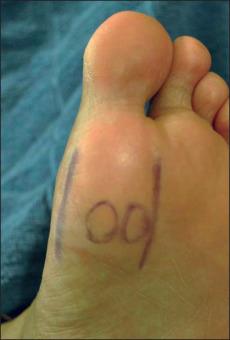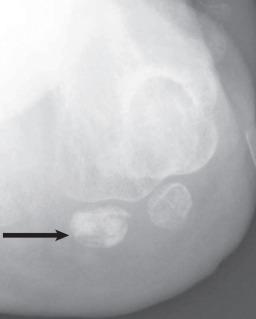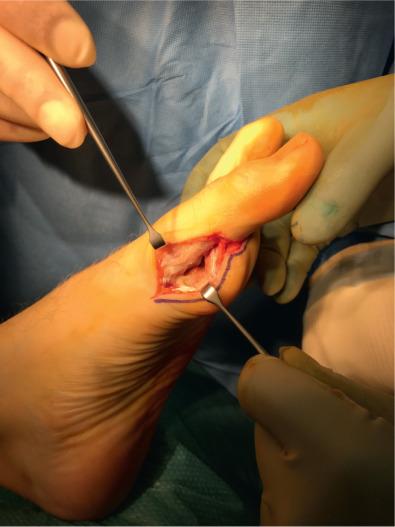Physical Address
304 North Cardinal St.
Dorchester Center, MA 02124
Great caution must be exercised in dealing with forefoot problems, particularly in athletes. Although the outcomes are the same as in nonathletes, even a small decrease in performance may prove to be very significant for an athlete. Therefore with certain exceptions, forefoot surgery should be considered only when conservative management has failed and the athlete is no longer able to play through the pain/dysfunction.
Metatarsophalangeal (MTP) joint injuries are commonly the result of hyperextension. They are increasingly common and can be characterized by a significant delay in return to sporting activities. Turf toe is more likely to occur on third-generation artificial surfaces versus grass, and is more than 13 times more likely to occur during a game as opposed to training. Analysis of the National Collegiate Athletic Association (NCAA) Injury Surveillance System for Turf Toe in Intercollegiate Football found an overall incidence of 0.062 per 1000 athlete-exposures. In a series of 20 male cadaveric feet, the first MTP joint was dorsiflexed to varying degrees and subsequently dissected to identify objective evidence of injury to the sesamoid complex, including tear in the soft tissue or avulsion fracture (deemed clinically relevant). Using binomial regression, a hallux dorsiflexion angle of 78 degrees had a 50% risk of first MTP joint sprain.
Players may report localized pain, swelling, and pain with range of motion (ROM) and ambulation; in addition, periarticular swelling and ecchymosis are typically present. Push-off is impaired with running, and it may be difficult to crouch with the MTP joint extended. Some patients, particularly elite footballers, may not present with an acute history and severe symptoms but may have an impending turf toe, so they should have early imaging.
Clinical evaluation should include evaluation of hallux alignment, including clinical MTP joint reduction, or the presence of an intrinsic-minus posture (i.e., MTP extension and interphalangeal flexion), suggesting disruption of the flexor hallucis brevis (FHB) tendon insertion. Palpation of plantar (including the individual sesamoids), medial, lateral, and dorsal structures for focal tenderness should be performed. Assessment of joint stability with respect to dorsoplantar and varus/valgus stress is critical. Weakness in plantarflexion strength of the hallux may indicate loss of integrity of the plantar plate or the FHB. Point tenderness over the plantar aspect of the first MTP joint that worsens with passive extension of the toe is indicative of injury.
Bilateral weight-bearing anteroposterior (AP) views can identify proximal migration of the sesamoids. A forced dorsiflexion lateral view assists in the diagnosis of failure of distal sesamoid migration and diastasis of a bipartite or fractured sesamoid. The normal diastasis of a dominant foot bi- or multipartite sesamoid is on average 0.79 mm; it has been suggested that the sesamoid interval of more than 2 mm on AP radiograph of the foot is abnormal, with no statistically significant difference between gender, age, laterality of sesamoid, or foot dominance. Weight bearing and stress radiographs of both feet are useful to document relative proximal migration of the sesamoids on the injured foot. Magnetic resonance imaging (MRI) plays a crucial role in early and accurate diagnosis of structures involved in “turf toe” injuries. Systematic assessment of the MRI can detail the integrity of the paired confluent metatarsosesamoid (MT-S) ligaments, paired sesamoid-phalangeal (SP) ligaments, the intersesamoid (IS) ligament, medial and lateral collateral ligaments, accessory collateral ligaments to the sesamoids, tendinous insertions and confluences with the plantar capsule, as well as the sesamoids, cartilage and alignment. It is important to focus MR imaging on the first MTP joint during the assessment of turf toe by using an extremity coil with the joint at its isocenter as opposed to imaging the entire foot or forefoot.
MRI can be used to evaluate the presence and extent of capsular or plantar plate disruption and also osseous or articular damage in the presence of normal radiographs. Rodeo and coworkers have proposed a classification of first MTP joint injury, as shown in Box 121.1 .
Localized tenderness, swelling, and pain with dorsiflexion
Normal radiographs
Conservative treatment
Ecchymosis, painful dorsiflexion, and loss of motion
Diastasis of a partite sesamoid or joint instability on radiographs
No degenerative first metatarsophalangeal joint changes
Conservative or surgical treatment
Loss of motion
Degenerative joint disease, hallux rigidus, or malalignment on radiograph
Treatment is often surgical
Operative intervention is rarely necessary in acute grade I and II injuries. Management is usually centered on conservative methods because surgery can be associated with a restricted ROM. However, up to 25% to 50% of patients will have residual pain and limited dorsiflexion despite 6 months of rehabilitation ; some authors have therefore recommended surgical treatment of type III injuries. On average, ligamentous turf toe results in a mean 9.1 days lost from play, whereas sesamoid fracture results in a mean of 42 days lost. Some patients will be out of elite-level competition for almost 6 months.
A recent algorithm for the management of turf toe was suggested by Hong et al. in 2016. Grade 1 injuries can be treated with taping of the toe in slight plantarflexion for 3 weeks followed by a carbon fiber orthotic for 6 to 8 weeks. Grade 2 injuries are treated with a walking boot and crutches for 2 to 4 weeks and then, again, with a carbon fiber turf toe orthotic for 6 to 8 weeks. It is suggested that grade 3 injuries need surgical repair. Surgery should also be considered for sesamoid retraction or fracture, traumatic hallux valgus, first MTP joint instability, intra-articular loose bodies, or failed conservative treatment. Ice, compression, and nonsteroidal anti-inflammatory drugs may be used. However, activity should be restricted in athletes with more severe injuries and significant discomfort. The patient can continue to participate in athletics if pain is minimal. A rigid forefoot insole to stiffen the shoe and taping of the toe to compress the joint and limit dorsiflexion motion all help reduce pain. For grade III injuries, immobilization and a period of restricted weight bearing is usually required for up to 8 weeks.
Return to sport depends on the severity of the injury, the resolution of symptoms, and the athlete's sport or position. Ideally, painless 60-degree dorsiflexion will be achieved in the first MTP joint before running or explosive activities are attempted. Serial examinations are important because deformity can progress with athletic activity.
Less than 2% of cases require operative treatment. Operative treatment is necessary in more severe injuries with joint instability, retraction of the sesamoids, diastasis of a bipartite sesamoid or sesamoid fracture, traumatic hallux valgus, or the presence of a loose body or chondral injury. Arthroscopy is helpful in evaluating the injury, but an open approach (plantar medial with extension across the MTP joint if required) is most helpful; however, care must be taken with the plantar-medial nerve. Repair of the plate distal to the sesamoid can be achieved with suture anchors into the base of the proximal phalanx. Care must be taken to avoid overtightening this repair. Despite open repair and direct visualization of the lateral sesamoid, it is recommended that intraoperative imaging may help the surgeon ensure that the plantar plate is tensioned adequately. Similar techniques can be used for diastasis of a bipartite sesamoid. Postoperatively, patients are often placed into cast, boot, or splint for 4 to 6 weeks, followed by a resistive ROM program and running at 18 weeks. Return to full participation in collegiate football can take 6 months.
The patient is positioned supine with the heels at the end of the operating table. Dual incisions are recommended to repair a grade III turf toe ( Fig. 121.1 ). A longitudinal medial incision is centered at the first metatarsophalangeal joint to access the medial sesamoid.

Care is taken during dissection to leave a cuff of joint capsule for closure at the conclusion of the case. The medial plantar digital nerve lies adjacent to the sesamoid and should be protected. A longitudinal plantar incision is commonly used for the lateral sesamoid. The lateral plantar digital nerve is at risk during this approach and must be identified and protected to prevent neuroma formation.
The plantar plate is then repaired from lateral to medial with use of nonabsorbable or slow- absorbing suture. Care must be taken to avoid damage to the flexor hallucis longus. In the absence of tissue along the proximal phalanx, use of a suture anchor to secure the plantar plate has been described. Fracture of both sesamoids should be treated with cerclage of the sesamoids to restore continuity of the flexor hallucis brevis and avoid a cock-up toe deformity. If one of the two sesamoids has severe articular damage, excision can be performed. However, in no case should both sesamoids be excised. Standard closure should be performed.
Postoperative management must balance soft tissue healing with early ROM of the MTP joint. Immobilization in a removable splint (a toe spica splint in 5 to 10 degrees of plantarflexion with slight varus) with restricted weight bearing continues for 4 weeks. Seven to 10 days after surgery, passive ROM is begun. At 4 weeks, weight bearing and active ROM are initiated in a walking boot. Wearing of modified footwear (i.e., a shoe with a stiff sole modified with a turf toe plate) is allowed at 8 weeks, with return to full sport at 3 to 4 months.
Contrary to the common perception, evidence points to good outcomes when appropriate treatment is instigated. Most athletes with grade I and II injuries (53 of 56 in a series by Clanton et al. ) returned to sport within 3 weeks with careful conservative management. Even with grade III injuries, Anderson found that seven of nine players returned to sport; two failed to resume playing because of pain and degeneration.
After a turf toe injury, athletes can experience persistent pain with toe-off and stiffness of the first MTP joint ( Table 121.1 ). Instability, deformity, and degeneration can occur if the injury fails to heal well.
| ANDERSON CLASSIFICATION | ||
|---|---|---|
| Type of Injury | Grade | Description |
| Hyperextension (turf toe) | I |
|
| II |
|
|
| III |
|
|
| Hyperflexion (sand toe) | Hyperflexion injury to hallux MTP or IP joint | |
| May involve injury to lesser MTP joints as well | ||
| Dislocation | I |
|
| IIA |
|
|
| IIB |
|
|
| IIC |
|
|
The sesamoid complex of the first MTP joint plays a significant role in the function of the great toe ( Box 121.2 ). Sesamoid dysfunction is uncommon; however, it can occur with arthritis, trauma, osteochondritis, infection, or sesamoiditis. Abnormalities and complaints regarding the sesamoids of the hallux are much more common in professional athletes than in others because of the stresses the first MTP joint is subjected to during athletic activities.
Protects the tendon of the flexor hallucis longus
Absorbs most of the weight bearing on the medial aspect of the forefoot
Increases the mechanical advantage of intrinsic musculature of the hallux
Elevates the first metatarsal head
The medial sesamoid is more commonly injured than is the lateral sesamoid because it bears greater force during normal gait. The plantar lateral and plantar medial digital nerves are located adjacent to the lateral and medial sesamoids. Impingement of either one of these branches may be a source of pain in the area of the sesamoids. Osteoarthritis of the sesamoids has been reported in association with hallux valgus, hallux rigidus, and rheumatoid arthritis and as an isolated occurrence. When it is associated with a high-arched or cavus type of foot, a plantarflexed first ray may be the cause of the callus formation. When a sesamoid is involved, a more localized or concentric lesion is usually present.
The most frequent subjective symptoms are pain and discomfort in the toe-off phase of gait located directly plantar to the sesamoids.
A cavus foot or gastrocnemius contracture increases forefoot loading and therefore should be specifically assessed. A plantar keratosis beneath either the tibial or fibular sesamoid may occasionally accompany a symptomatic sesamoid. Another method to support the diagnosis of sesamoiditis is the use of the passive axial compression test. This is performed with the patient supine. After the sesamoids have been isolated, the hallux is maximally dorsiflexed at the MTP joint, which will cause distal migration of the sesamoids. The examiner's index finger is used to apply compression just proximal to the sesamoids. The patient's symptoms are reproduced with passive plantarflexion of the MTP joint as the sesamoids are compressed against the metatarsal head and phalanx.
Often the most useful radiograph is the axial sesamoid view ( Fig. 121.2 ). Fragmentation of a sesamoid in persons with osteochondritis may be seen on the axial radiograph. Radiographs are frequently normal despite subjective symptoms (sesamoiditis). MRI is one of the best methods for diagnosing disease of the sesamoids. Osteochondritis can be visualized very early, usually before any abnormality is seen on plain radiography. It is also useful in visualizing soft tissue abnormalities of the sesamoid mechanism.

Most sesamoid problems in the athlete can be treated effectively without surgery. If conservative treatment has been unsuccessful, several surgical options are available depending on the pathologic condition. When surgical intervention is being considered, a concomitant deformity such as a gastrocnemius contraction or cavus foot alignment must be addressed.
Activity and footwear modification, use of insoles, and treatment of the callosities are all helpful. In patients with sesamoid pain, a stiff insole or a rocker-bottom sole reduces metatarsal joint motion and can relieve pain with ambulation. The use of a dancer's pad, which is designed with a concavity for the sesamoids, is extremely useful in nearly all cases.
Surgical treatment includes a tibial or fibular sesamoidectomy as well as sesamoid shaving. Excision of a single sesamoid does not usually lead to deformity as long as careful operative technique is used. Removal of both tibial and fibular sesamoids is rarely indicated because it predictably results in the development of a cock-up and intrinsic-minus deformity of the hallux. Arthrodesis of the MTP joint with excision of the sesamoid may alleviate arthritic symptoms and provides a stable medial buttress to the first ray but it will severely compromise function in an athlete. Although a sesamoidectomy is occasionally necessary for cases of intractable plantar keratosis (IPK), surgical shaving of the involved sesamoid may preserve function in the athlete and facilitate a more rapid recovery ( Fig. 121.3 ). Sesamoid shaving or resection in the presence of a plantarflexed first ray is associated with a high rate of recurrence of the keratotic lesion.
Excision of the affected sesamoid with use of the previously described incisions is the treatment of choice except in the case of an intractable plantar keratosis. Care must be taken to avoid damage to the flexor hallucis brevis and flexor hallucis longus. The soft tissue defect must be repaired to avoid iatrogenic deformity.

After sesamoid excision, a soft compression dressing is used and the patient is allowed to ambulate in a postoperative shoe. Weight bearing on the heel is recommended to minimize soft tissue trauma to the forefoot and promote healing of the incision. Return to play after surgical intervention for sesamoid dysfunction is typically between 2 and 4 months after surgery. When shaving of the tibial sesamoid is performed, the athlete is allowed to resume running about 6 weeks after surgery.
Sesamoidectomy has not been described as a treatment for acute fractures or nonfragmented nonunions of the sesamoids. However, it has been described for sesamoiditis. Saxena and Krisdakumtorn reported a mean average return to activity between 7.5 and 12 weeks in 26 patients. Eleven professional/varsity athletes returned to sports at a mean of 7.5 weeks, whereas 13 “active” patients returned to sporting activity at a mean of 12 weeks.
Become a Clinical Tree membership for Full access and enjoy Unlimited articles
If you are a member. Log in here